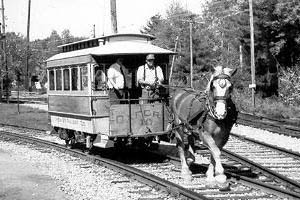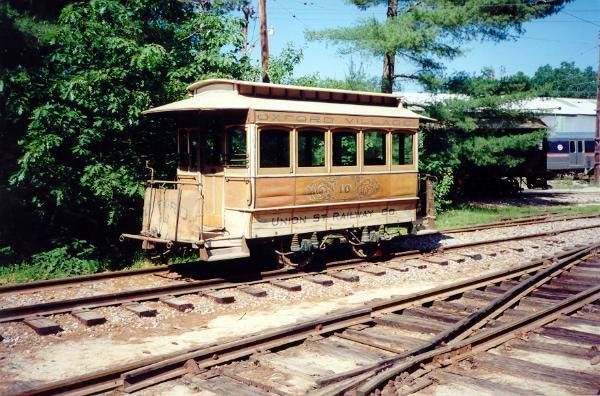
- Builder
- J. G. Brill Co.
- Description
- Horsecar
- Secondary Use
- None
- Type
- City and Suburban Streetcars
- Year
- 1885
- Retired from Service
- 1954
- Acquired by the Museum
- 1954
- Fund
- 866
Union St. Ry. 10
From New Bedford, Massachusetts
History
The New Bedford & Fairhaven Street Railway began horsecar service in New Bedford, MA in 1872. It became the Union Street Railway in 1887. The company began converting to electric streetcars in 1890.
Sixteen foot closed horsecars were the state-of-the-art in the mid-1880s and were used on about every system in the country. There were two major varieties, single ended “bobtails” operated on circular routes, or double-ended cars used on point-to-point routes. The bobtails also could be operated with only a driver, while the double ended cars required a conductor to guard the rear doors and collect fares. The latter type was more common, as they loaded and unloaded more quickly and were more adaptable to variations in operation. No. 10 is a typical example of a double-ended car, built in 1880 or 1885 (sources differ). It was normally pulled by a single horse at 6 to 8 miles per hour. The car operated a short shuttle route on North Main Street in Fairhaven, MA (originally, Oxford, for which the car is lettered). The Union Street Railway used this car well into the 1890s, and then retired it to serve as a tool shed. In 1914, the company decided to renovate and repaint No. 10 for special events. The railway brought out No. 10 to run on July 4, 1914. Union Street Railway stored No. 10 under a tarp at its Weld Street carhouse. No. 10 often made appearances on the street on special occasions, such as in 1922 when New Bedford celebrated its 50th anniversary of street railway service.
Very few sixteen-foot cars remained by the 1910s, and even fewer have survived into the 21st century. Car 10 is a classic example of these once-ubiquitous cars. No. 10’s paint scheme features fancy scroll work on the sides of the car.
Union Street Railway donated No. 10 to Seashore in 1954. At the time, Seashore did not have indoor space for No. 10. So, Seashore initially loaned No. 10 to the Larz Anderson Museum in Brookline, MA before bringing it to Kennebunkport in 1955. No. 10 was also exhibited at the Antique Auto Museum in Princeton, MA. In 1958, the Metropolitan Transit Authority borrowed No. 10. The MTA mounted it on rubber tires and pulled it through Boston streets with a horse and a mule for an advertising campaign. Seashore occasionally hired a horse to pull No. 10 for visitors. After loaning No. 10 to Newburyport, NH for a parade in 1977, Seashore decided to stop sending the car out of the museum. No. 10 has not been repainted or refinished since being retired. It is the only unmodified horsecar at Seashore and is among the oldest vehicles in the collection.
Technical Information
- Seats: 18
- Control: Reins
- Brakes: Hand
- Compressor: None
Trucks
- Number: 1
- Manufacturer: Brill
- Model: Pedestal
Weight and Dimensions
- Length: 17’ 9.00"
- Width: 7’ 8.00"
- Height: 9’ 7.00"
Additional Images

Frederick Maloney at newdavesrailpix.com
© 1998 - 2025 New England Electric Railway Historical Society. All Rights Reserved.